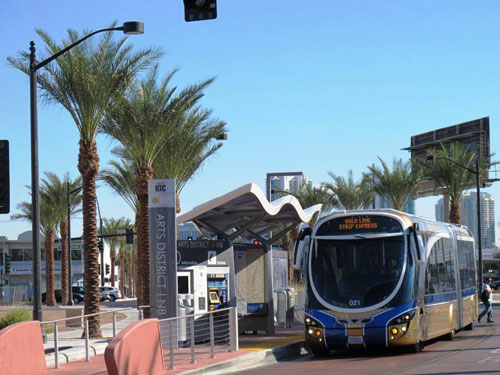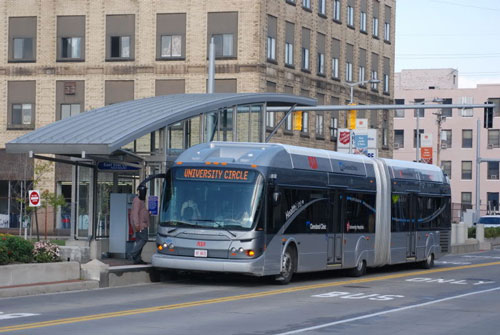With Millennials leading America’s historic decline in driving, cities are exploring ways to attract young professionals through reliable mass transit. Benjamin de la Pena and Nicholas Turner argue that Bus Rapid Transit is the optimal solution.

Young people across the country are decreasing the amount they drive and increasing their use of public transit. Meet Jacob Curtis, a 29 year old young professional who was recently featured in The New York Times. Jacob moved to Charlotte for a new job. He found a home close to bus and rail lines. His home is in a location where he can ride his bike to the office along a no-traffic greenway. During his off hours, he navigates the Queen City easily thanks to his smartphone, which helps him plot routes that blend biking and mass transit options.
Sound familiar? It should, because Jacob is just one example of many Millennials who would rather use public transportation, bike-share or walk instead of drive. According to a report [PDF] just released by U.S. PIRG Education Fund and the Frontier Group, 16 to 34-year-olds drove 23 percent fewer miles on average in 2009 than in 2001 (a decrease from 10,300 miles to 7,900 miles per capita). Over that same period, the number of passenger miles traveled per capita by 16 to 34-year-olds on public transit increased by 40 percent.
Contributing to this shift in transportation choices among Millennials is the fact that many young people – especially after the Great Recession of 2008 - are choosing to live in urban communities that are walkable and well connected by mass transit. Seventy-seven percent of Generation Y plans to live in an urban core, according to consumer research [PDF] by economic development practice group RCLCO. Like Jacob, a growing number of young people are choosing public transit instead of cars to get to school or work and to visit their family and friends.
The Baby Boomer generation also plays a role in this shift in driving patterns, as they pass through their prime driving years and head toward retirement. They, too, are taking their foot off the gas. With this shift happening at both ends of the age spectrum, the conversation around transportation planning in the U.S. has to change at the same time.
Attention City Leaders
Many city leaders recognize the need to build better public transportation systems to attract and retain these highly-skilled young professionals and empty nesters. Mayors working to grow their local economies, become more competitive and attract an educated workforce realize that good mass transit is an essential asset. Yet, the current fiscal environment presents a formidable challenge to building and delivering these high-quality mass transit systems economically and quickly. So, what type of public transportation systems should cash-strapped cities invest in – buses, streetcars, subways?

Enter Bus Rapid Transit (BRT). As one of the easiest and most cost-effective ways to expand and modernize public transportation, BRT is a high performance mass transit system that delivers the permanence, speed and reliability of rail systems, along with the flexibility of bus systems, for a fraction of the cost. The components of high-quality BRT systems include high-capacity vehicles, dedicated lanes, elevated platforms that are level with the vehicles, enclosed stations and off-bus fare collection.
The flexibility and cost effectiveness of BRT make it an excellent choice for cities and transit agencies facing both increasing demand for transit and increasingly constrained budgets. It’s also ideal for young people looking for fast, reliable transit options, and even baby boomers looking to retire and live a car-light lifestyle.
The cities that want to be competitive – that want to attract the talented Millennials and the moneyed and retiring Baby Boomers – are looking to high-quality BRT so they can rapidly deploy the transportation options demanded by these critical generations.
BRT Done Right
When built to a high standard, BRT can do much more than move people quickly and comfortably – it can help to make entire cities more livable. Cities around the world – from Cleveland, Ohio to Guangzhou, China – have seen BRT systems enhance the commuter experience, improve the streetscape, revitalize city centers and improve air quality. City leaders across the United States and abroad are using high quality BRT as part of a strategy to make their cities more competitive.

Take Cleveland, which opened the HealthLine in 2008, connecting the city’s main employment centers – including downtown Cleveland, the Cleveland Clinic and University Hospital – with more than 200,000 employees and 58,000 households within just a half a mile. The 6.8 mile HealthLine along Euclid Avenue, recently named the best BRT system in the U.S. by The Institute for Transportation and Development Policy (ITDP) and rated a high Silver on the global BRT Standard, features high-quality BRT attributes such as off-board fare collection, median-aligned bus-only lanes and at-level passenger boarding. In just three years, ridership has increased more than 60 percent over the bus routes that formerly ran along the corridor. Passengers have reported average time savings of 12 minutes, and average speeds along the corridor have increased 34 percent compared to previous service. The HealthLine is a powerful example of the impact BRT can have on development. Over $4.3 billion has been invested in rehabilitating old buildings into housing and retail centers, as well as major expansions to nearby universities, museums and hospitals – helping to lure more business into the area and spur economic growth.
More places in the U.S. -- Chicago, Pittsburgh, Nashville, Alameda County, CA and Montgomery County, MD among them -- are starting to explore BRT as a transit solution and are setting their ambitions high.
In Chicago for example, the proposed Ashland Avenue BRT corridor – which has the highest ridership on the Chicago Transit Authority’s (CTA) bus system – was selected as the city’s first attempt at Gold Standard BRT in an effort to provide faster, more reliable bus service by 2016. The service is expected to cut travel times by 80 percent and quickly connect riders to CTA rail lines, bus lines, as well as major medical centers and universities. The BRT route will operate 24-hours a day and feature a dedicated center bus lane in each direction. Passengers will pay fares at center-island stations and board through doors on the left side of the double-long buses. The bus floors will be level with the station platform for quicker boarding and exiting, and transponders on the buses will communicate with traffic signals to extend green lights for the buses, which would make limited stops.
The Rockefeller Foundation has been supporting Chicago’s efforts to develop a city-wide BRT system for several years, and recently announced a $1.2M grant to support local efforts in building BRT systems in the Windy City and other major urban centers across the country including Boston, Nashville and Pittsburgh. Overall, the Foundation has invested over $6M in support of expanding BRT over the past three years. As these cities and other metropolitan areas in the U.S. continue to grow, investments in the right mass transit is critical to encouraging economic development and to making communities more livable – and high-quality BRT delivers.
Benefits Beyond Transportation
But this is not just about hipsters and empty nesters. It is also about an opportunity for cities to seize on the ingenuity and capabilities of their entire population. BRT systems that are built to a high standard can make a real difference in metro regions by providing better access to jobs and services. There are scores of low-income communities in cities across the country that desperately need convenient access to reliable mass transit. Many residential communities are far from where the majority of jobs exist, and getting to work is a challenge day in and day out. Making three or more transfers on different modes of transit is the norm and commutes can take upwards of 1.5-2 hours or more. According to a 2011 Brookings report, which looked at the nation’s 100 largest metropolitan areas, only about 22 percent of metropolitan jobs in low and middle-skill industries are accessible by public transportation in under 90 minutes.
If U.S. cities are to become more livable, competitive and inclusive, mayors and metro leaders should look closely at BRT as an important element of their strategies to modernize their transportation systems. As they know, now more than ever it is important to find creative solutions to providing affordable transportation options that meet the needs of our communities and residents and keep our economies moving forward.
Nicholas Turner joined the Rockefeller Foundation in 2007. As a Managing Director, Mr. Turner provides leadership and strategic direction for select Foundation initiatives, currently leading the Foundation’s work on Transportation reform in the Unites States and New Orleans redevelopment initiative.
Benjamin de la Peña is Associate Director for Urban Development at The Rockefeller Foundation where he works on issues related to cities, informal settlements, transportation, information technology, urban science and urban policy.

Planetizen Federal Action Tracker
A weekly monitor of how Trump’s orders and actions are impacting planners and planning in America.

Congressman Proposes Bill to Rename DC Metro “Trump Train”
The Make Autorail Great Again Act would withhold federal funding to the system until the Washington Metropolitan Area Transit Authority (WMATA), rebrands as the Washington Metropolitan Authority for Greater Access (WMAGA).

The Simple Legislative Tool Transforming Vacant Downtowns
In California, Michigan and Georgia, an easy win is bringing dollars — and delight — back to city centers.

The States Losing Rural Delivery Rooms at an Alarming Pace
In some states, as few as 9% of rural hospitals still deliver babies. As a result, rising pre-term births, no adequate pre-term care and "harrowing" close calls are a growing reality.

The Small South Asian Republic Going all in on EVs
Thanks to one simple policy change less than five years ago, 65% of new cars in this Himalayan country are now electric.

DC Backpedals on Bike Lane Protection, Swaps Barriers for Paint
Citing aesthetic concerns, the city is removing the concrete barriers and flexposts that once separated Arizona Avenue cyclists from motor vehicles.
Urban Design for Planners 1: Software Tools
This six-course series explores essential urban design concepts using open source software and equips planners with the tools they need to participate fully in the urban design process.
Planning for Universal Design
Learn the tools for implementing Universal Design in planning regulations.
Smith Gee Studio
City of Charlotte
City of Camden Redevelopment Agency
City of Astoria
Transportation Research & Education Center (TREC) at Portland State University
US High Speed Rail Association
City of Camden Redevelopment Agency
Municipality of Princeton (NJ)




























